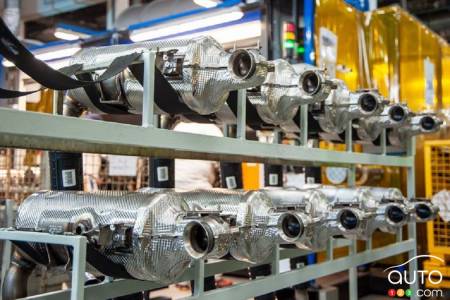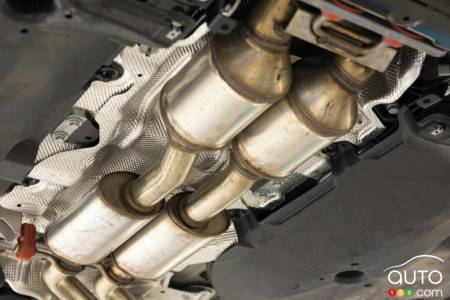• U.S. federal authorities have dismantled a nationwide catalytic converter theft ring.
• The criminals were primarily interested in the metals contained in the converters, including platinum, palladium and rhodium.
• A catalytic converter can be sold for a few hundred dollars on the open market, but it costs much more to replace on a vehicle (approximately $1,000 to $2,500).
On both sides of the Canada-U.S. border, stories vehicles’ catalytic converters being stolen have become commonplace in recent years and particularly over the last year.
There are tens of thousands of victims of this particular theft in North America.
The catalytic converter is a part of the exhaust system in use with North American vehicles since the 1970s; it’s there to make exhaust gases from internal combustion engines less toxic by converting substances such as carbon monoxide, nitric oxide, nitrogen oxide and hydrocarbons into less harmful carbon dioxide and water vapor.
The attraction of catalytic converters to criminals has come from the fact that they it contain precious metals that can be sold at a premium, including platinum, palladium and rhodium.
Browse cars for sale available near you

In recent years, the value of these metals has increased dramatically. In March 2021, Global News reported that the price of palladium had risen from about $200 USD per ounce 12 years ago to nearly $2,300 per ounce. By comparison, gold rose from $1,100 to $1,700 per ounce over the same period.
And it's worse in the case of rhodium. At the beginning of 2009, the metal was worth $1,100 U.S. per ounce; it was valued at more than $26,000 per ounce in 2021.
It’s easy to understand why criminals are interested. It’s estimated that each catalytic converter stolen and sold can fetch between $100 and $500 depending on the model. The profit margin can climb up to $1,500 per unit for a large truck.
To give you an example of the explosion in thefts, a quick look at the numbers in British Columbia is instructive. In 2015, 146 converter thefts were recorded in the province. That number jumped to 1546 in 2020. Those kinds of increases have been seen cross North America.
Not surprisingly, we learn that theft groups have increasingly take the form of organized networks. After all, what's the point of stealing a converter if you can't resell it?
Now, one of those networks in the United States has been dismantled. And we could see a lull in the number of thefts as a result.
The Federal Bureau of Investigation (FBI) said that the network of thieves, dealers and processors was able to pocket tens of millions of dollars from the stolen converters.
The operation, which involved local, state and federal law enforcement officers, led to the arrest of 21 people across five states. They were charged in two separate indictments.
Federal grand juries in California and Oklahoma filed separate charges for conspiracy to transport stolen catalytic converters and conspiracy to commit money laundering, among others. In total, what was seized is worth over $545 million.
It remains to be seen if these arrests lead to reductions in the number of thefts in Canada. Again, without a network to sell and dispose of the stolen goods, the criminals have less incentive to go out and get them.



